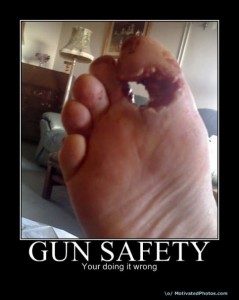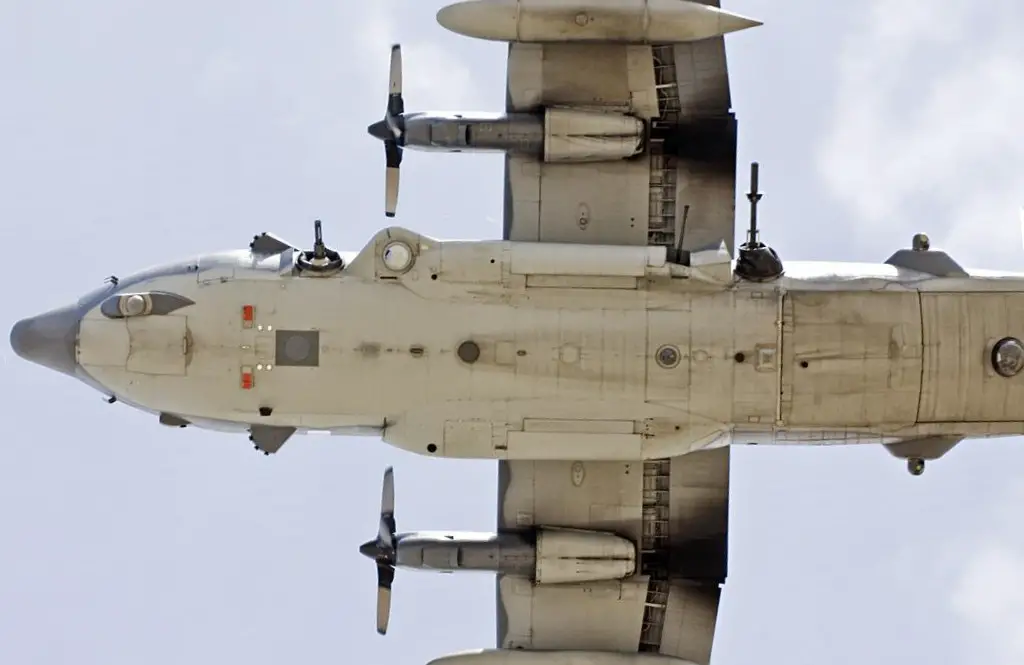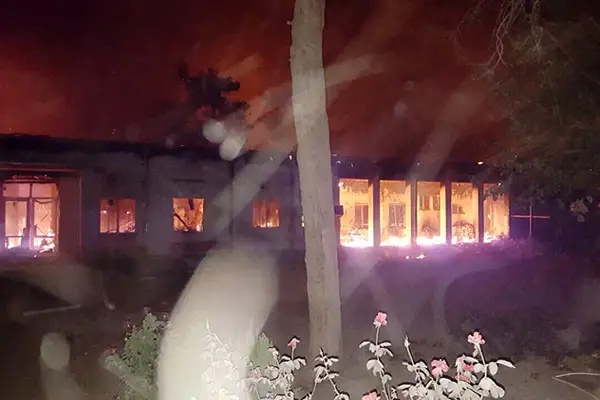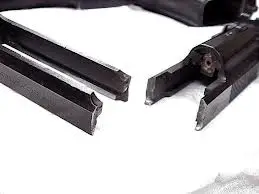 On July 29, a fool participating in one of the Cody Gunfighters’ Old West shows in Cody, Wyoming, fired a cylinder of live cap-and-ball shots, fortunately missing the guys playing the other side of the gunfight, but unfortunately hitting not one but three spectators.
On July 29, a fool participating in one of the Cody Gunfighters’ Old West shows in Cody, Wyoming, fired a cylinder of live cap-and-ball shots, fortunately missing the guys playing the other side of the gunfight, but unfortunately hitting not one but three spectators.
It was not the first incident in the long-running open-air Western entertainment, but the first in a long time. In 1983 Thornton “Todd” Darr was wounded in the hand by a blank at contact range; in 1988 Dave Boehm lost most of the sight of an eye from some blank-launched flying particle. These accidents led to a time-out; the current iteration of the Gunfighters seems to date to 1996.
The July incident is still under investigation, the Cody Enterprise reports.
Malfunctioning blanks weren’t the problem in July, however. The performer who shot the live rounds grabbed the wrong cylinder, one he normally used for target shooting, and it was loaded.
That gun, which has been sent to the state crime lab for testing, was a cap and ball type. Baker said he still has not received results of the testing. The Cody Police Department report of the incident will not be released until Baker has received the crime lab’s report.
Cap and ball revolvers don’t use modern brass cartridges, but instead use black powder loaded through the muzzle with lead round balls ramrodded on top of the charge. There is no commercially manufactured blank round for this type of gun.
While a favorite of many re-enactors, the design of cap and ball revolvers means this type of gun isn’t as easy to check for live ammunition as a brass cartridge revolver. That’s in part because cap and ball revolvers are susceptible to a dangerous condition known as chain firing. Chain firing occurs when sparks from the cylinder intended to be fired ignites black powder residue in an adjoining cylinder. This can cause the second cylinder to fire accidentally.
The writer is trying here, but he’s crossed up the concepts “cylinder,” the thing on the revolver that holds all the chambers, and “chamber,” the hole bored in the cylinder that holds a single individual cartridge or (on muzzle-loading cap-and-ball revolvers) charge. Still, he or she is trying.
To prevent chain firing, many shooters add grease to the cylinder, covering the roundball. This prevents the spark from following the powder train into another cylinder.
Again, read “chamber” for “cylinder” in the line above… and in the line below.
Unfortunately, the grease also makes it difficult to tell with a visual inspection whether there is a roundball in the cylinder. The shooter has to instead push a pin through the grease to detect the ball beneath.
All this means the iconic cap and ball revolver, with its distinctive profile shaped by the ramrod mounted under the barrel – a gun so prized by many aficionados of classic Old West firearms – will no longer be used in the show.
The popular show will now continue with cartridge firearms only, and with blanks supplied by the show managers only.
Facing new safety guidelines imposed by the City after a July performance went awry, a spokesman for the Cody Gunfighters said the group’s shows won’t resume in 2016.
Richard Muscio, a founding member and past president of Cody Gunfighters, said the group needs more time to be in compliance with the guidelines….
The Gunfighters do intend to be back in the summer of 2017 with a revised show.
The Cody Gunfighters carry $2 million in liability insurance.
Chiappa Chiappa Bang kBANG!
Here’s a Chiappa Rhino 2000DS revolver that has more or less reverted to kit form, kinetically.
Now, you may have seen this before (about a quarter-million people have looked at the original post on Imgur as of now).
Poster saith (on Reddit):
This is a friend of a friend occurrence. This is what they told me: New gun and factory ammo at the range. They fired approximately 70 rounds when this happened. It blew the pad off his index finger. They just finished reconstructive surgery. I’m assuming it was caused by a squib. I’ll post more when I learn more.
…
And now the money shot…
We’ve got the missing finger for you, after the jump for the squeamish among ye.
Continue reading
Negligent Discharge: The Shooter’s Story
 This story was told by a Marine, Private Johnathan T. Markert, while he was in the the Marine brig at Camp Hansen, Japan, for the negligent homicide of a friend. We believe that he has since been released from confinement on completion of his sentence.
This story was told by a Marine, Private Johnathan T. Markert, while he was in the the Marine brig at Camp Hansen, Japan, for the negligent homicide of a friend. We believe that he has since been released from confinement on completion of his sentence.
You’ve heard the basic safety rules for handling weapons and undoubtedly will hear them again. Maybe you’ve heard them so many times you’re getting tired of them. But it’s vitally important that you understand these rules, accept their value, and, above all, follow them when you’re handling a weapon in any situation. Believe me, I know.
As we will see, his problem was not just a violation of common safety rules, but a complete lapse of self-discipline.
I graduated boot camp and infantry school with ease, and I was eager and motivated to hit the fleet. Being sent to Hawaii was a dream come true. Senior Marines were very encouraging and told me I was going to go places in the Corps. We went on our annual unit deployment program to Okinawa, Japan, and I couldn’t have been more excited. I was assigned to stand post as a sentry at the gates of Camp Hansen, which would involve handling loaded 9 mm pistols. Not a problem for me; I thought, “I’m a machine gunner and a pistol is my secondary weapon. I know this gun inside and out.” Unfortunately, I disregarded basic safety rules and ignored what a 9 mm round can do to a human being.
You wan to guess what comes next? If it were a crime, it would be “clowning with a firearm, First Degree, your honor.” But we’ll let Markert describe it:
On a quiet Sunday evening in June 2003, two Marines and I were scheduled for duty at one of Camp Hansen’s gates. We climbed into the back of a HMMWV to be driven to post. A quarter-mile ride to the gate was all it took for my life to change and a fellow Marine’s life to end.
A close friend and I pulled out our 9 mm pistols and began to play around with them. We pointed the weapons in all directions, including at each other; put them on “fire; ”and cocked the hammers. We then began a mock tussle, which was all it took for my pistol to fire.
My world stopped moving at that point, and a tragedy began for me, my friend, our families, and many others. I went into shock and thought it couldn’t be happening, but it was happening right in front of me. I’d shot my friend and fellow Marine in the head.
I froze as he slumped to the floor of the HMMWV. Blood pooled on the floor as I scrambled to give him first aid. By this time other Marines had converged on the HMMWV. Someone said he was dead, but I found he still was breathing.
I thought I could stop the bleeding with my shirt. But as I wrapped the shirt around his head, I felt tissue and other matter near the wound. I feared for my friend’s life and was numb with despair by the time EMT personnel arrived and took him from my arms. They took him to the hospital, where he languished for 8 days before succumbing to the wound I’d inflicted.
And then, as the saying goes, his troubles began.
I was handcuffed and taken to the provost marshal’s office, where the investigation and the longest night of my life began. The investigators asked detailed questions and focused on our horseplay. The process was painstaking and added a helpless feeling of regret to my fear and despair. I couldn’t see—let alone accept—that a moment of foolishness could lead to something so horrible. I was placed under suicide watch after questioning and on legal hold and liberty risk upon my release.
We’d like to add at this point that the M9 is an extremely safe firearm, to the extent that such an oxymoron can ever be true. It has several positive safeties, including a heavy first-round double-action trigger pull; a positive visual and tactile loaded-chamber indicator; and a simple operating system that can be taught to a basic operator in a couple of hours. It has been operated safely by literally millions of troops since its 1980s introduction. (And some of us had our hands on M9 precursors in the late 70s).
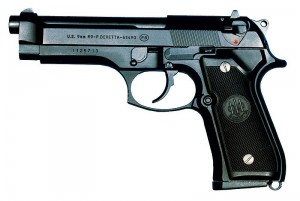 But even this idiot-proofed weapon can’t compete with the natural skills of the improvisational idiot. He ignored the passive safeties and defeated the active ones, including the double-action lockwork of the pistol. He never looked at or finger-swept the loaded chamber indicator. He put it in a state of readiness to fire, and then, according to all the survivors, engaged in some kind of tussle. His buddy was just as big an idiot for playing along with him.
But even this idiot-proofed weapon can’t compete with the natural skills of the improvisational idiot. He ignored the passive safeties and defeated the active ones, including the double-action lockwork of the pistol. He never looked at or finger-swept the loaded chamber indicator. He put it in a state of readiness to fire, and then, according to all the survivors, engaged in some kind of tussle. His buddy was just as big an idiot for playing along with him.
This is a relatively rare example of someone being court-martialed for a negligent discharge. It’s understandable in the light of the consequences, and, not to put too fine a point on it, in the light of Markert’s lowly rank at the time (about to get lower, of course). People make excuses for higher ranking officers in similar circumstances, but the services land with both feet on a junior enlisted guy.
This kind of make-an-example-of-him approach is hard on the negligent shooter, but he’s damaged, probably irreparably, at that point, so why not use him to send a message pour encourager les aûtres?
Six months of agony and anguish passed before my court-martial, which was as heart-wrenching as a funeral and as bad as reliving your worst nightmare. Facing more than 20 years in prison and discharge from the Corps was very frightening and difficult. However, nothing was as hard as seeing and hearing what my friend’s mother, father, and sister had been through. I also had to face the effect my trial had on my own mother and brother-in-law, a former Marine who’d accompanied her to Okinawa for support.
I stood up at sentencing and told my friend’s family how sorry I was. Somehow they were able to graciously accept my apology. I believe they understand their son was my close friend and his death was an accident. Even so, I must live each day knowing I killed my friend and a good Marine.
No matter how skilled or comfortable you are with a weapon, the basic safety rules still apply. Remember “Treat, Never, Keep, Keep:”
- Treat every weapon as if it’s loaded
- Never point your weapon at anything you don’t intend to shoot
- Keep your finger straight and off the trigger until you’re ready to fire
- Keep your weapon on safe until you intend to fire
I write this from the brig as a discharged Marine with the belief I can be of some help to anyone who reads or hears my story. This tragedy, with all its pain and suffering, could’ve been avoided if I’d simply followed the above rules. Weapons don’t care if you’re just playing around and have no regard for you, your skill, intentions, or brother Marines. It’s you who must think and act with care and purpose.
What a tragic story. And what a price paid by all concerned — including Markert and his Marine buddy — for two young men’s carelessness.
Sure, he seems to have matured considerably while in prison. But as he observed, his life has taken on a new direction. May he make the best of it.
Safety: “The gun didn’t kill my boy. I did.”
 Sometimes, words fail. This range accident is one of those times.
Sometimes, words fail. This range accident is one of those times.
The father who accidentally shot and killed his teenage son at a Florida firing range on Sunday has spoken out, saying that it was his ‘operating error’ that caused his son’s death, not the gun itself.
William Clayton Brumby, 64, was shooting with son Stephen J Brumby, 14 at High Noon Guns in Sarasota when he accidentally fired backwards and fatally wounded his son.
‘The gun didn’t kill my boy. I did,’ Brumby told CNN Monday. ‘Every round in the gun is your responsibility. When it fires you need to stand to account for it. That’s what I’ve spent the last two days doing: accounting for my operating error.’
Read that last paragraph a second time, please. We did.
This is a guy who, in the aftershock of having done absolutely the wrong thing, is now doing absolutely the right thing. In the middle of his ocean of heartbreak.
Mr Brumby told the channel that he had taken his son and two of the youngster’s six siblings – his 24-year-old brother and 12-year-old sister – to the range that day just as he did every other month.
The family has always trained their children to fire weapons from an ‘appropriate age,’ he said.
‘We wanted our kids to be aware of guns,’ he explained. ‘I wanted them to be comfortable around them and understand them.’
But it was at one of these routine visits that disaster struck: A hot shell casing, newly ejected from a gun, bounced back into Brumby’s shirt.
‘Brumby then used his right hand, which was holding the handgun, in an attempt to remove the casing,’ a police statement later said.
‘While doing so, he inadvertently pointed the firearm directly behind him and accidentally fired.’
That’s what the cops said. And Brumby?
‘It was a very freak accident. I made a mistake,’ he said.
‘It doesn’t take but a split second for something to go wrong…”
Boy, isn’t that the truth.
Clayton Brumby also took the time, on the TV, to tell the world what a person his error had cost the state of Texas, the country, and the human race.
But the grieving dad didn’t just talk about his son’s death – he also talked about his life, and his hobbies, which included not just shooting, but also bass fishing, tennis, and playing piano at church.
Stephen was also ‘sweet’ and a hard worker at home, he said, helping out with the family and acting as both caregiver and friend to his youngest sister, who has spina bifida.
His father also hoped that once he finished homeschooling with his mom, Stephen would go on to college like his older brothers – and if he had, Brumby said, he would have gone far.
‘He had a heart that was bigger than he was,’ Clayton Brumby said. ‘He was always thinking outside the box.’
Please be careful out there. Like Clayton Brumby says, they’re our bullets and we own every one. Naturally, the Brit reporters at the Daily Mail don’t miss the chance to insult and abuse Brumby, so for once we’ll tell you not to Read The Whole Thing™. To Hell with a bunch of Piers Morgan wannabees.
So — what’s the take-away from a case like this? We’ve seen guns aimed wild many times because a hot casing went in an open collar. Anyone who’s ever been a range officer has to have seen it. It’s one reason we like turtle and crew necks for the range, and one reason your grouchy old sergeant always wanted your sleeves down on the range, even when it’s hot.
If you’re the shooter, and you get a hot case, force yourself to secure the gun first. Very, very hard to do when you’re being burned, but it’s a life or death thing. If you’re the coach or the next relay, always maintain your focus on the shooter’s gun. If it starts coming towards you, block it, or redirect it. It is, once again, a life or death thing.
And be conscious that such an accident can happen. That’s probably the biggest single precaution you can take.
Striker-Fired Gun Loose in a Bag = Bad Idea
Unfortunately for a former member of the Indianapolis Colts, this is one of the cases where Experience gives the examination before the lesson, and since the student has assumed ambient temperature, the retest will not be scheduled.
A former NFL player died Tuesday after accidentally shooting himself in the stomach.
Zurlon Tipton, 26, a former Indianapolis Colts running back, was dropping off his car at a dealership in Roseville, Michigan when he reached into a bag, firing a gun inside.
Tipton was hit in the abdomen and taken to the hospital. He was alert and able to talk during the transport, police said according to the Detroit News.
But officials confirmed on Tuesday afternoon that Tipton had died.
Not that unusual. Exsanguination internally; he popped the round into a major vessel or an organ that was heavily vascularized.
Tipton, who had a young daughter, went to get a transmission leak on his vehicle fixed between 9 and 9:30 Tuesday morning, the car dealership’s manager Mark DeMara told the Detroit News.
He was putting his personal belongings inside the bag when the shooting happened, authorities said.
Holsters, people. Also, one gun in your car and your little ditty bag of personal stuff you don’t trust your car dealer with is plenty.
Tipton has some history with guns, says the Detroit News:
Early Christmas morning Tipton was arrested for firing a gun outside his girlfriend’s home in the Indianapolis area, according to police. The Indianapolis Star reported Tipton was charged with criminal recklessness with a deadly weapon. According to media reports, the prosecutor’s office declined to pursue charges against him.
Tipton told Greenwood police he went to the home after he received threatening texts from his girlfriend’s ex-boyfriend stating the woman was going to be harmed. Believing the ex-boyfriend was inside the home, Tipton fired one round from an AR-15 assault weapon, police said.
The Colts put him on waiver last December, although what relation (temporal? Causal? None?) this has with his 2015 gun problem is unknown.
Update
Between writing this and it going live, two young (23-24 years old) knuckleheads in Stoughton, Mass., were playing with several things that ought not to be mixed:
- A firearm, to wit a pistol, legally licensed to one of the individuals;
- Judgment Juice™, which both of the worthies had consumed in super-therapeutic quantities; and,
- Some kind of camera(s) with which they were filming their tomfoolery.
It is our observation that the presence of a camera lowers the IQ of all within range approximately 30%. And the dyscognition produced by ingested ethanol is well known. While private drunkenness is not society’s business, private drunkenness with firearm escalates the behavior from Mere Stupid, which is the normal operating level for a large part of society, to Felony Stupid.
As you might expect, one drunk pointed the gun at the other drunk, pulling the trigger and expecting a “click.” It gives a new meaning to the term Dead Drunk.
Dead Drunk his ownself is on a mortuary slab, awaiting autopsy, and Dead Drunk’s Buddy is on house arrest with an ankle bracelet, awaiting trial. His license to carry has been revoked and the local cops have divvied up his other guns, if any with one of the two politically connected “bonded warehouses” that scam guns with the help of the police.
Mama Gump used to always say, “Stupid is as stupid does, but not for long if stupid does it with booze and a gun.”
Safety: This is Doing it Wrong
The first report was dry and brief, but was enough to let anyone know that something had come unglued seriously:
Officials say a man has been fatally shot in an apparent accident during a concealed carry class at a gun shop in Ohio.
The Clermont County sheriff says the unidentified man was shot in the neck around 1 p.m. Saturday and died at the scene. There were about 10 people in the concealed carry class when the shooting occurred at KayJay Gun Shop in Amelia, about 20 miles east of Cincinnati.
According to the gun shop’s website, the class taught basic pistol safety, gave attendees range time and reviewed Ohio’s gun laws.
via Man fatally shot in accident during class at Ohio gun shop.
The first story neither identified the victim, nor explained anything about how this happened. More detail was soon available on Fox 19:
The owner of a gun shop was accidentally shot and killed during a concealed carry class in Amelia, the Clermont County Sheriff’s Office confirms.
Crews responded to the the Kay Jay Gun Shop on Lindale-Mt. Holly Rd. around 1 p.m. on Saturday for reports of a shooting.
Clermont County Sheriff A.J. Rodenberg said James E. Baker, 64, was shot in the neck after a class participant discharged a handgun while practicing weapon malfunction drills, striking Baker who was sitting in an adjacent room.
Investigators said efforts to resuscitate Baker were unsuccessful and he was pronounced dead at the scene.
Something went seriously wrong in that class.
If the Four Rules (or however many are in your version) had been followed assiduously, nobody gets shot. A firearm has zero tolerance for inattention to detail.
UPDATE 1
An updated story described neighbors’ and friends’ feelings of loss (warning, autoplay video with loud ad. The mute button is your friend):
Baker’s gun shop offers a long list of training courses to teach people to use guns like rifles and pistols the correct way.
Now, many in this tight-knit community say they are devastated knowing he won’t be here to do that anymore.
“He’s just a great guy, I mean, I can’t believe it happened, it’s hard to believe, just a really good guy,” Fritz said. “I’m going to miss him because he was a good neighbor.”
We also talked with a man who lives just a few houses down from where it happened.
He told us Baker gave him his very first job, calling him a great boss and friend.
Investigators aren’t saying what type of gun was used or if any charges will be filed.
Update 2
(Warning, autoplay video again). The Investigation continues, with more details trickling out.
In a media release, the Clermont County Sheriff’s Office said, “Investigators discovered that a class participant discharged a handgun while practicing weapon malfunction drills, striking Baker who was sitting in an adjacent room. Efforts to resuscitate Baker were unsuccessful and Baker was pronounced at 3:12 p.m.”
Baker regularly conducted gun training sessions.
A friend and fellow Vietnam-era veteran took a session a couple years back and said Baker was careful and experienced.
“When I took the class, nobody had a loaded weapon,” said Dennis Cooper. “I mean, you could bring your own weapon, but it had to be cleared.”
A friend at a nearby gun shop didn’t want to be identified, but said Baker had close law enforcement connections and helped to build area SWAT units.
He seemed stunned at how this went down.
Immediately after it happened, a 911 caller told the dispatcher, “We were doing malfunction misfires and we have plastic bullets and we just, I just, we just double checked the bullets and there was a live round in one of the guns and it went through the wall and shot the owner in the neck.”
Those who knew Baker feel the loss deeply.
A father and his young son placed a potted flower at the property gate Monday.
We’re told Baker was a Marine sniper in Vietnam about 45 years ago and let police in the area use his target range to recertify as they must do each year.
We wonder why they were doing malfunction misfire drills during a basic CCW class.
Hey, Dude, Where’s My Guns?
 That was the question a Sanford, FL detective was asking when he went back to his Ford Explorer after a softball game and found his back window smashed open — and two guns, his cuff key, body armor and badge gone.
That was the question a Sanford, FL detective was asking when he went back to his Ford Explorer after a softball game and found his back window smashed open — and two guns, his cuff key, body armor and badge gone.
D’oh. The smash-and-grab theft was one of two at the park that day, but the other guy didn’t have guns locked in his car (and if he wasn’t a cop, would have gotten in trouble if he had… since the guy who armed a criminal is a cop, he faces no consequences more serious office mockery). Nope, what the thieves got from the other victim was a diaper bag. (So much for our master plan of hiding our guns inside a diaper bag).
After shattering the window, someone grabbed the detective’s department-issued Sig Sauer pistol, his personally-owned Remington 870 shotgun, body armor, a handcuff key, a stun-gun cartridge, radio microphone and his law-enforcement badge. The items have a combined estimated value of more than $3,400, the report states.
The Orlando Sentinel rounds up other local cop theft victims:
Guns are a popular item among thieves who target law-enforcement officials.
Earlier this month, thieves robbed a retired FBI agent of his credentials and gun while he napped inside his car outside a business in Altamonte Springs. And in a 6-month span last year, there were at least three separate incidents of guns disappearing from law enforcement vehicles in Central Florida.
Two the incidents involved Orange County sheriff’s deputies and the other a Winter Park police officer. It’s unclear if any of the weapons stolen in those cases were found.
Don’t worry about it. They’ll turn up in gang murders. Hopefully it’s only the gang members who get murdered, which is just Evolution in Action® (“Evolution in Action®” is a registered trademark of Niven and Pournelle).
While it’s fun making fun of law enforcement, nothing feels like being ripped off, except perhaps being raped. And the biggest reason we have such a high level of theft, apart from living in a low trust society produced by unassimilated immigration, and racial and ethnic identity politics, is that punishment for the thieves is neither swift, nor sure, nor sufficient. We still think malum in se felony sentences should be simplified to 10-20-Life, with no parole, no probation, no plea bargains. A second arrest while on pretrial release should nullify pretrial release rights for life. Get the pathogens out of the bloodstream, and the patient gets healthy.
Then, there’s this little two-liner from the Sentinel:
How often law enforcement vehicles are burglarized isn’t known, as agencies rarely alert the public.
Sanford police released information about the incident on Saturday as a public safety notice, saying a statement that residents “should be aware of the possibility of police impersonation.”
Good on Sanford for doing the right thing in this case, and really, it’s better to get this kind of news out in public with your own spin on it, and look like you give a damn, rather than look like you’re covering up.
Who Steals Guns? Violent Criminals. Duh.
This is not news to anybody, except, it turns out, the news media. This year the New Orleans Times-Picayune discovered that, to their shock and horror, criminals steal guns.
No $#!+, Sherlock. Criminals steal stuff. It’s what they do.
But it seems to have really blown the NOLA reporters away that such a things happen. It seems to have twaumatized their ban-the-guns-end-crime simplistic, childish worldview. They are shocked that criminals in the Crescent City have made off with 2,100 plus guns, the theft of which was reported to the NOPD, between 2012 and 2015.
No reporter writes a story to inform his readers any more; it’s always a crusade to Change the World. The paper’s agenda in this case is to help their party’s politicians push a proposed mandatory-reporting law. But in support of that push, they gathered some interesting interviews and statistics.
Here are the Times-Picayune stories:
‘I put guns out on the street’: Gun theft victims speak out. The paper notes that some owners are careless, leaving guns in unlocked homes or in cars. But others get ripped off despite using safes. Best you can do is have a list of your serial numbers — and not just in your laptop that the same thieves will bug out with.
5 tips to prevent your guns from being stolen. These are pretty much standard, and won’t stop a determined thief. Still, not all thieves are determined, and not all gun owners take these precautions.
Video: Stolen Weapons Fuel Street Violence. (It doesn’t seem to occur to them that violent criminals either seek to steal weapons, or seek to buy them from thieves).
3 stolen guns, 3 New Orleans violent crime scenes: How stolen guns fuel crime. Three case studies of guns used in robberies and murders (twice, wrested away from the criminals, and once, used to shoot the bastard stone cold graveyard dead. Woot).
An interactive-map sidebar to that article shows that 10 NOLA stolen guns didn’t leave town, but were used by local robbers and murderers. Another interactive tells us that:
- Stolen guns are used in crime (they keep harping on this, but it’s not an Einstein level insight).
- 3 guns a day are stolen in the NOLA metro area of the city and adjacent Jefferson Parish.
- The thousands of guns stolen in the metro area are used in shootings that kill innocents (they cite an example where 17 and 19 year old gangbangers missed each other but nailed an uninvolved 15-year-old girl inside a nearby home.
- In 2015, NOLAs theft total of 582 breaks down as
- 203 vehicle break-in
- 149 theft or auto theft (not burglary)
- 106 residential burglary
- 64 all others (lost, armed robberies, etc).
- The reporters interviewed some gun-theft victims. Of 44 guns these 11 victims lost to theft in 2015-16, only 2 have been recovered. The other 42 presumably still circulate in criminal channels.
- Almost half the time, the owners had no record of their stolen firearms’ serial numbers.
- Most NOLA murders are shootings (149 of 164 in 2015, 91%). To this we’d add, that’s pretty normal for North American major cities.
- ATF estimates that 60+% of gun thefts are never reported. (What percentage of those is various criminal underclass members stealing from one another is not clear). The latest number the ATF has (based on actual theft reports) is 190k, but they think 500k is more reasonable, to account for those theft victims who do not report guns stolen.
Lessons Learned
If there’s one lesson in the whole thing it’s don’t leave your gun in the jeezly car. If there’s two lessons, the second one is take a picture of the GD serial number and store it in the cloud. You might even get your gun back, after the cops pry it out of some worthless gangbanger’s cold dead hands.
Expanding Beyond NOLA
The ATF has released a study on calendar 2015’s gun thefts. The data are a little more solid, and the writing not nearly as breathless as the Times-Picayune’s, but it’s not constrained to any one city, either.
Because, naturally, New Orleans’ criminal element is not the only one awash in stolen guns these days. In Phoenix, an open-carrier found his gun grabbed by a lightfingered crook, and then used to discourage him from pursuing. Open carry is tactically inferior to concealed carry, folks. Even when you’re not getting your guns stolen and used aginst you. And open carry in a non-retention holster? Sheesh. Watch the video at that link. Don’t be that guy.
In Cleveland, gun show thefts led cops to a thief who was also a suspect in violent crimes. (Well, duh. What sort of person would steal guns, except a violent criminal?)
In Philadelphia, Officer Josh Hartnett was shot by a convert named Abdul Shaheed, whom the Philadelphia press continues to call by the non-jihadi name he had rejected, Edward Archer, perhaps to distract people away from questions about motive. Shaheed attacked Hartnett with a stolen gun. The gun was a Glock from Hartnett’s own department. It was one of a couple dozen department firearms that are missing at any given time.
The Konduz Report

This AC-130 time exposure was shot over Iraq, but it’s pretty typical. The tracers are a psychological weapon.
The US military has finished its investigation into the attack on the Konduz Trauma Center operated by Médecins sans Frontières (Doctors Without Borders) in the early hours (local) of 3 October 2015.
The story of the attack is as simple as it is banal: the guys on the ground and the guys in the air miscommunicated, and the ground guys identified the wrong building to the air guys, who then destroyed it, as requested. But the identified target wasn’t the compound full of Talban; it was the NGO’s hospital.
On Sep. 30, 2015, Sep. Afghan forces and a small element of US Special Forces attempted to re-take the City of Kunduz, which had been seized by the Taliban. The US and Afghan forces established a small base on an Afghan Police compound in Kunduz and repelled several Taliban attacks between Sep. 30 and Oct. 2. The US Special Forces element on the ground had been engaged in heavy fighting for nearly five consecutive days and nights at the time of the airstrike on Oct. 3.
On the night of Oct. 2, 2015, the Afghan forces decided to attack an insurgent-controlled site, and requested air support from the US Special Forces element on the ground. An AC-130U Gunship was directed to provide the requested support. The AC-130 launched from its airfield in Afghanistan 69 minutes earlier than the crew had originally planned due to an emergency call, so they did not get all the information they would normally have received before a mission. While en route to Kunduz, one of the AC-130’s critical communications systems failed, resulting in an inability to receive updates from and transmit information to multiple command headquarters. Additionally, after arriving in the operating area, due to significant threats to aircraft in Kunduz, the AC-130 took defensive measures that degraded its ability to locate ground targets. These factors all contributed to the incident.
When the aircrew arrived near Kunduz in the early morning on Oct. 3, 2015, they attempted to locate the Taliban-controlled target site. The Afghan forces provided the correct grid coordinates for the target site to the U.S. Special Forces commander on the ground, who then relayed them to the aircrew through a Joint Terminal Attack Controller (JTAC). Due to distance of the aircraft from the location at issue, the aircrew was initially unable to locate the target structure. When the grid coordinates were entered, the system directed the aircrew to an open field. The aircrew then attempted to visually identify the target structure based on a description relayed from the Afghan forces through the JTAC.
Based on this discussion over communications systems, the aircrew identified a structure that they believed to be the Taliban-controlled target structure, but was actually the MSF Trauma Center. Before the engagement, one aircrew member, the TV Sensor Operator, identified the correct structure as possibly fitting the described target. However, following several attempts to clarify which structure was the actual target requested by the Ground Force Commander and the JTAC, the aircraft’s weapons systems were redirected to the originally viewed structure (MSF Trauma Center). The MSF Trauma Center generally matched the general physical description of the Taliban-controlled target structure which was approximately 400 meters away.
The investigation identified several human errors by the aircrew and ground personnel that contributed to this tragic incident, including poor communication, coordination, and situational awareness. The investigation confirmed that MSF officials provided the correct grid coordinates for the MSF Trauma Center to several U.S. government officials and that the location was properly entered on the U.S. military’s “No Strike List” database, but that the aircrew did not have ready access to this database during the strike. The investigation also concluded that the MSF Trauma Center did not have an internationally-recognized symbol to identify it as a medical facility, such as a Red Cross or Red Crescent that was readily visible to the aircrew at night. Throughout the couse of the engagement, all members of the ground force and the aircrew were unaware the aircrew was firing on a medical facility and mistakenly believed that it was firing on the intended target, an insurgent-controlled structure approximately 400 meters away from the MSF Trauma Center.
At approximately 2:08 a.m. local time on Oct 3, 2015, the aircrew began firing on the MSF Trauma Center under the mistaken belief that it was the Taliban-controlled target compound. Starting at approximately 2:19 a.m. MSF personnel notified several US government representatives that the MSF Trauma Center was being engaged. Due to the fighting around Kunduz, it was initially unclear who was engaging the MSF Trauma Center. Following a series of relayed messages through multiple echelons of command, the U.S. Special Forces commander on the ground eventually realized that the AC-130 was engaging the MSF Trauma Center – not the Taliban-controlled structure the crew believed it was engaging – and halted the strike at approximately 2:38 a.m. The investigation determined that the steps taken by several U.S. military personnel during this period were inadequate. The investigation found that the airstrike resulted in at least 30 deaths and 37 injuries at the MSF Trauma Center. Since the investigation was completed, MSF has increased the number of reported casualties to 42 deaths and 229 other claims. The US Government has relied primarily upon MSF for casualty estimates, and these numbers have not been independently verified.
That pretty much wraps the factual summary of the report. To state the conclusions in the more direct terminology used by, say, NTSB:
- The mishap was indeed an accident, not a crime.
- The probable cause of the accident was the USAF AC-130’s misidentification of the MSF Trauma Center as a nearby enemy-held structure.
- The attack continued for 11 minutes before MSF contacted US HQs and concluded after 19 more minutes when the USSF commander on the ground finally realized the AC was striking the wrong building.
- Contributing factors included:
- System failures on the AC-130;
- Procedural shortcuts, ditto;
- Delays at US headquarters, caused in part by the ponderous nature of those HQs;
- Lack of a night-vision-readable protective marking on the hospital (we doubt the US has advised MSF and other protected-structure owners how to mark their structures so that the markings are visible in NV or thermal observation devices, so this is less an indictment of MSF than it appears).
There are numerous other small cock-ups — the whole paper trail is hundreds of pages long — that could be added to the list, but those are the big ones.
The whole thing might have been forestalled, or at least stopped sooner with less loss of life, had the USSF been further forward, but that would violate ROE dictated from Washington and designed solely with a view to domestic politics.
These conclusions are unlikely to satisfy those howling for scalps, so 16 scalps have been provided for their education and recreation.
It is notable that the Afghan National Forces, who often take a savage briefing in the Beltway press, do not seem to have committed any of the significant errors. Unlike in the last Battle of Konduz, in 2001, neither the Taliban nor the Afghan National Forces, appear to have included significant numbers of Konduz natives, yet the Afghan Army provided the correct grid coordinates to the USSF element and their JTAC. The JTAC committed several procedural errors (for which he has been decertified), but provided the correct grids to the orbiting AC-130. The AC crew, not for the first time with this airframe, had screwed their navigation systems up to the point where they decided to disregard them completely and work by eyeball. (That exact same thing was a significant factor in the last AC-130 botched strike we’re aware of, in 2002. We are certain that the AC crew studied that attack, but in the heat of combat did not recognize that they were falling into the same pattern that the 2002 mishap crew did).
 Most of the press focus has been on the scalp counting, briefly described here:
Most of the press focus has been on the scalp counting, briefly described here:
The investigation identified 16 U.S. service members whose conduct warranted consideration for appropriate administrative or disciplinary action. The Commander of US Forces-Afghanistan concluded that certain personnel failed to comply with the law of armed conflict and rules of engagement. However, he did not conclude that these failures amounted to a war crime. The label “war crimes” is typically reserved for intentional acts — intentionally targeting civilians or intentionally targeting protected objects.
The comprehensive investigation concluded that this tragic incident was caused by a combination of human errors, compounded by process and equipment failures. The investigation found that this combination of factors caused both the Ground Force Commander and the air crew to believe mistakenly that the air crew was firing on the intended target, which was an insurgent-controlled site approximately 400 meters away from the MSF Trauma Center.
Just as an aside, we’d note that the same analysis of culpability probably applies to the Russian Army shootdown of an airliner over the Ukraine. It wasn’t a war crime, just a tragic screwup. But the difference between the two nations’ responses is interesting. Can you download the Russian internal report, even with redactions? Did they accept any blame and pay any compensation? Rhetorical questions.
One of the real underlying problems here is the limits of back-up inertial navigation on airborne systems. It was cutting edge technology in 1966, and was, and is, good enough to get a nuclear missile to minute-of-city accuracy. Given modern solid-state accelerometers, it should be a lot better. But the irreducible problem with INS is that it’s vitally dependent on starting at an accurate known starting point. GIGO is in effect here.
Another contributing factor is certainly the five days of unrelieved combat the ground forces had been in at the time. This is caused, partly, by the drawdown and by ROE that prioritize the appearance of operations over the reality of operations.
Unfortunately, included in the hundreds of pages of recommendations is more procedure-lock, more lawyer supremacy, more bureausclerosis of all kinds.
It’s classic US Military response to a disaster: do more of what caused it.
We struck out trying to find a releasable, selectable-text version of the document on a public-facing website. This document at cryptome appears identical; we OCRd an executive summary for discussion here. If time permits, which at the moment it doesn’t, we suspect we’d find a lot more of interest in these 727 pages. (To be sure, probably 600 of those pages are almost blank military forms, or content-free boilerplate, but we haven’t got time to sort out the sheep from the goats right now).
Small News Items on Army Small Arms
There’s a bunch of little news bits going around the Army about maintenance issues and problems. We’ll cover them from most to least serious:
Item: Somebody Blew It
In late 2015, a very high (but unknown) round count M9 pistol had a catastrophic failure of the slide. With the Army scrimping on O&M money, especially on the ripe-for-replacement Beretta handgun, failures are not unusual and usually turn out to be fatigue failures from parts that have been carelessly used long past their service life. So was this one. The pistol was older than the soldier shooting it, and, as it turned out, someone, somewhere had pencil-whipped the maintenance records.
Slides fail every week, somewhere in an Army with hundreds of thousands of pistols that were almost all bought 30 years ago. But what happened next wasn’t supposed to happen. When the pistol slide failed at the slide’s weakest point, the locking-block cuts, the rear half of the slide kept on motoring, striking the GI in the cheek and upper jaw area and causing non-life-threatening injuries.
The investigation determined that a mandatory maintenance work order, MWO 9-1005-317–30-10-1, issued twenty-seven years ago in March, 1989, had never been complied with. They couldn’t track where the pistol was at the time it was not repaired; Army units and activities with M9s had until June, 1993 to comply.
Somebody reported that his M9s were in compliance, when they weren’t. This is what you get when a zero-defects, up-or-out culture undermines integrity while at the same time penny-pinching undermines maintenance. The soldier who drew that defective M9, and every soldier that’s been drawing and shooting it since 1989, is damned lucky to be alive. (Fortunately, when a slide fails on most pistols (or a bolt on a Mauser C96, etc.), gravity usually ensures that the part hits below the eye, on cheek, jaw, chest or shoulder).
Meanwhile, the Army sent an urgent Safety-of-Use message mandating an Army-wide inspection of all M9s for completion of the MWO. Since the resources for completing the MWO no longer exist, the remedial action is to immediately deadline and turn in the offending M9 and draw a replacement.
How many units pencil-whipped their response to that ALARACT message?
Item: Safety? Sometimes it’s Evolution in Action
 Word is, some genius removed himself from the breeding population of Homo sapiens in 2014 by “improvising” M203 ammo (may have been 320) by cutting the links off of (higher-pressure) Mk19 belted ammo. The links were actually designed so they couldn’t snap off by hand, to prevent that.
Word is, some genius removed himself from the breeding population of Homo sapiens in 2014 by “improvising” M203 ammo (may have been 320) by cutting the links off of (higher-pressure) Mk19 belted ammo. The links were actually designed so they couldn’t snap off by hand, to prevent that.
Can we get a “FOOM!” from the assembled multitudes?
And oh, yeah, trying to belt up 203 ammo and fire it in an Mk 19 leads to FOOM also, of a different variety — out of battery ignition. Another opportunity for poka-yoke missed.
Item: Ambi Selectors Reaching Troops.. slowly
The Army has finally woken up to two facts:
- About 10% of the troops are left-handed, and
- There are lots of good ambi selectors available.
So the Army chose one and put it into the pipeline. So far so good, right? Not entirely. The selectors are only being replaced when the weapons are overhauled. And they don’t fit in the M12 racks many units still have. Work around is to cut a notch in the rack with a torch, or with a file and plenty of time, or to bend the part of the rack that hits the right-side selector out of shape so that the selector clears the rack.
Also, the slow migration of the ambi selectors means not all M4/M16 weapons in any given unit have them. Why don’t they just push the parts down to the unit armorers? Three reasons:
- The big one: they’re afraid of armorers stealing parts if they take rifles apart
- It doesn’t fit the concept of echeloned maintenance, even though that’s being streamlined;
- They don’t trust the armorers let alone the Joes, not to botch the installation.
On top of that, of course, it’s not penny wise and pound foolish in the great Army tradition.
Item: New Stuff Coming in, Old Stuff Going Out
A number of new arms are reaching the troops, and old arms are going away. We’ll have more about that in the future, especially the M2A1 and the coming “rationalization” of an explosion of shotguns and sniper rifles. We just broke it out of this post to keep the length manageable.
ITEM: MG Maintenance Problems = Operator Headspace & Timing
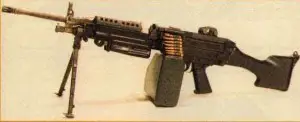 The biggest single problem the Army has with the current pair of machine guns (M240 and M249) is burned out barrels. That’s caused by not changing barrels, either in combat, or especially on the range. Often, units go out without the spare barrel so it’s not like they gave themselves any option. (The M2 version of this is going out with only one set of gages for the M2s. The gages are not required for the M2A1). The Army is falling back into the peacetime mindset of “leave it in the arms room and we can’t lose it.” True enough, we’ll just destroy the one we take out instead.
The biggest single problem the Army has with the current pair of machine guns (M240 and M249) is burned out barrels. That’s caused by not changing barrels, either in combat, or especially on the range. Often, units go out without the spare barrel so it’s not like they gave themselves any option. (The M2 version of this is going out with only one set of gages for the M2s. The gages are not required for the M2A1). The Army is falling back into the peacetime mindset of “leave it in the arms room and we can’t lose it.” True enough, we’ll just destroy the one we take out instead.
The fact is, and it’s a fact widely unknown to GIs, MGs have rate-of-sustained-fire limitations that are lower than they think. (Remember the MGs that failed at Wanat? They were being operated well outside their designed, tested envelope).
The M249 should never be fired more than 200 rounds rapid fire from a cold barrel. Then, change to a cold barrel, repeat. The Army being the Army, there are geniuses who think that they can burn a couple belts in a few seconds, change barrels, burn a couple belts in a couple more seconds, then put the original honkin’ hot barrel back in and burn — you get the idea. If you have a situation where you’re going to fire a lot of rounds from a single position, like a predeployment MG familiarization for support troops or a defensive position, you might want to lay in some extra barrels (and yes, Army supply makes that all but impossible, so you have to cannibalize your other MGs).
The M240 is a little more tolerant but should still be changed every 2 to 10 minutes of firing, and even more frequently if the firing tends towards real sustained fire. (The deets are in the FM, which is mostly only available on .pdf these days).
One last thought, your defensive MG positions need to have alternate, displace positions, and you need to displace after sustained fire from one position — unless you want to share your hole with an exploding RPG, ATGM or mortar round. “Where’s your secondary position?” or “-fallback position?” should not produce the Polish Salute.
As ordnance experts have observed ever since World War II, a barrel can be burnt out due to overheat and still mic and even air-gauge good. You only know it’s hosed when it can’t shoot straight.
Well-maintained MGs are more accurate than people seem to give them credit for. Some SOF elements have selective fire M240s and really, really like them. (The standard M240 has no semi setting). They’re capable of surprising accuracy from the tripod.
ITEM: For Want of a Cord, a Career was Lost
GIs frequently lose or throw away the idiot cord on the PVS-14 night vision monocular. If these sights were being properly inspected, which they usually aren’t until a team comes in just before deployment, they’d be tagged NMC (non mission capable) for missing that stupid cord. You don’t want to be in the bursting radius of a unit CO who’s just been told 85% of his night vision is NMC… especially when that news is delivered in earshot of his rater and senior rater. It’s a bull$#!+ requirement but it’s in the book, and if the Army ever has to choose between following the book or winning the war, the book comes up trumps every time.
You’re not going to stop GIs from losing cords, but replacement cords are in the supply catalog.

Kevin was a former Special Forces weapons man (MOS 18B, before the 18 series, 11B with Skill Qualification Indicator of S). His focus was on weapons: their history, effects and employment. He started WeaponsMan.com in 2011 and operated it until he passed away in 2017. His work is being preserved here at the request of his family.

